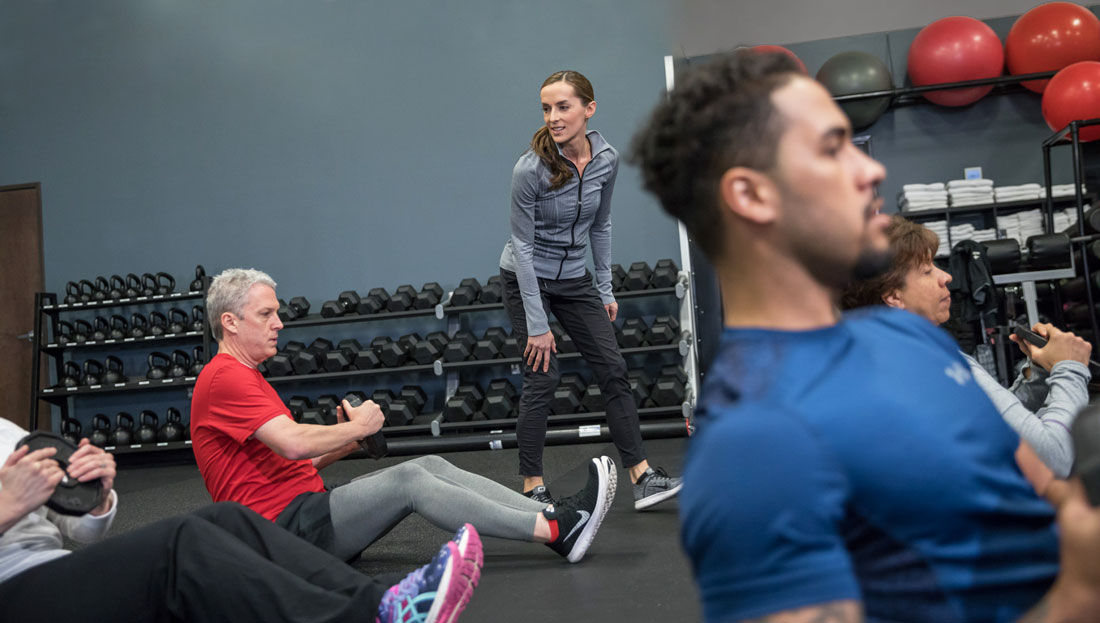
The practice of personal trainers leading group workouts continues to be a strong trend this year, as predicted in ACE’s 2018 trends report. And the reasons are clear: It’s an attractive business model that allows trainers to reach a range of clients while revving up revenue. Popular programs such as Orangetheory Fitness have also made coaching classes an exciting job prospect. Plus, clients love working out in groups because it’s great for camaraderie and budget.
However, any fitness instructor will tell you that group instruction requires precise skill sets. Trainers need a well-ordered plan to make the leap from working with one client at a time to leading groups, small or large. Here’s how to properly refine your personal-training knowledge and skills for a group setting.
Getting up to Speed with Group
A major difference between group and individual instruction is that the latter emphasizes personalization. One-on-one trainers have the luxury of presenting each client with the most suitable exercises possible during every moment of a workout. Group trainers have less control over customization—it’s a bit like training all your clients at the same time!
Generally, the more manageable the group size, such as three or four clients, the more you can and should continue to personalize.
“Small-group participants want the energy and sense of community from a group and the one-on-one attention from the coach,” says Jennifer Bach Hogg, co-founder of H.E.R.O. Fitness and the Group Fitness Education Manager at Lakeshore Sport and Fitness in Chicago.
Larger groups, fitness classes and boot camps are a different animal though. Unlike with a single client or very small group, it’s difficult to lead a large group in a style best suited to personal training. In fact, it’s ill advised.
Common Mistakes Trainers Make (and Simple Solutions)
Many trainers find it challenging to adjust from teaching one person at a time to instructing a bunch at once. Even if you apply many of the same principles and exercises to both scenarios, you’ll need to adopt different delivery, communication and motivation methods. Here are common mistakes trainers make when applying typical training tactics to groups, including how to develop more successful strategies.
Misplaced Attention
Although you can get quite detailed with one-on-one instruction, you’ll need to keep it more general as a group leader. This is true even if some people’s technique needs improvement.
“In a group setting it’s really hard to fix everything,” says Dan McDonogh, 2012 IDEA Fitness Instructor of the Year award recipient and an international educator, trainer and instructor in Portland, Ore. “If you see an individual performing an exercise incorrectly, pick the ‘fix’ that would make the biggest difference, then make a generic cue to the entire group.”
Always be ready to regress or progress exercises. “You have to be able to adjust on the spot to a member’s limitations or even to those who have none,” says Chas Rodgers, Director of FitWorx, LLC, and a fitness coach/consultant in San Diego. To do this well, get used to addressing the group as a whole most of the time.
Contrary to your instinct as a personal trainer, avoid too much individual coaching, suggests Myrna M. Brady, Group Training Coordinator at Life Time Athletic in Westchester, New York. “Often when this happens, it impacts member experience and the other clients/athletes feel left out,” she says. Plus, it interrupts class pacing and flow. “When you spend too much time trying to do manual or physical adjustments on people, you can lose track of your timing,” adds Hogg. All this could lead to undesirable outcomes, such as participants standing around wondering what to do next, having to ditch valuable exercises to make up for lost time and/or ending class behind schedule.
“With groups, you have to learn to juggle, and juggle well,” says Hogg. “If a ball drops, it's going to negatively affect the session because there is no pause button.”
At times when it’s absolutely crucial to take a one-on-one moment with somebody, be sure to accommodate others in class. “Have a move that your participants can execute if you spend extra time with just one participant,” says Lori Patterson, a U.S. Army vet and creator of Boot Camp Challenge in St. Peters, Mo., who has been teaching group exercise since 1984. “For example, they could hold a squat or jog the perimeter [of the studio or park] until you are back to facilitating the entire group.”
Finally, set yourself up for success with simplicity in both exercise selection and equipment. For example, in a single training session, you might pull out multiple fitness tools to use with a client. Managing that many “props” per person in a group can easily become a logistical headache, not just for spacing but also because it gets too confusing, especially if some participants aren’t adept at using certain pieces. The more complex the exercise and its associated equipment, the higher the chance that people will have trouble doing it without individualized attention.
Too Much Talking
Introducing complex exercises also hinders quick and efficient explanation—too much preamble is a problem. “Trainers tend to talk too much while explaining and demo’ing the exercises while participants remain idle,” observes Patterson. This kills class energy.
“If it takes more than 30 seconds to explain what you want them to do, participants start to lose interest,” says McDonogh. “In a group setting, people just want to move.” He suggests breaking down exercise instruction into three straightforward steps. Tell them: (1) what exercise to do, (2) for how long, and (3) at what intensity. “Once they start moving, explain how they can do it better,” says McDonogh. No surprise, group fitness instructors are particularly good at multitasking.
“Learn how to educate on the go,” adds Patterson. “For example, educate participants on the purpose of the squat, why it is important and how it will benefit them while they are executing it.” Also, strategize how and when to present information, so you can avoid what Brady calls “group paralysis” by over-analysis, over-coaching and over-instructing. “I tell the coaches that I mentor to ‘Tell it, show it, let the client do it,’” says Brady. “Step back, observe, coach and intervene when necessary. Offer one or two simple verbal cues that will help redirect behaviors.”
Hogg observes that group trainers tend to underutilize verbal and visual communication when trying to engage everybody. She suggests a “model and follow” style, which is a group-fitness tradition based on visual learning. In addition to hearing cues, participants like to watch the leader perform an exercise, even if it’s only for a few seconds. Once the group is busy doing the exercise, you can transition to verbal coaching.
Low-key Energy
Many trainers are skilled at motivation, but not necessarily in a group context. You have to be pretty animated to move a group, especially because participants play off your energy.
“Group exercise is always moving and it’s always motivating,” says Hogg. “Personal training is more subdued and moves at a pace based on a slower, controlled environment. Trainers need to understand that if they are going to cross over to group training, they need to keep people engaged and get them all to perform together. It’s like a well-choreographed dance.”
Developing this skill takes time, but you can jump-start success by defining and cultivating your unique coaching style, which might differ between group and one-on-one. “Practice it, polish it and present it several times until you feel you can flow with it in a larger setting,” says Rodgers.
Finally, when it comes to motivation, music really helps, so take advantage of this group-fitness mainstay if it suits the setting.
“Music sets the tone for a class from beginning to end,” says Brady. There are companies that create music specifically for boot camps, circuits, HIIT classes, etc., or you can compile a DIY playlist (being sure to obtain all the appropriate music licenses, of course) that appeals to the masses with various genres. Review and work out to playlists before bringing them to the group to ensure an appropriate and uplifting mix. “Even a basic understanding of music helps elevate a coach’s class instruction and experience,” says Brady.
High-Level Group Instruction
A trainer’s in-depth knowledge and keen eye for exercise technique are certainly helpful for teaching groups. But any high-level group leader demonstrates additional strengths, as defined in this article. Successfully working with groups of any size is within your reach when you blend your fitness expertise with a mastery of group instruction.





 by
by 


